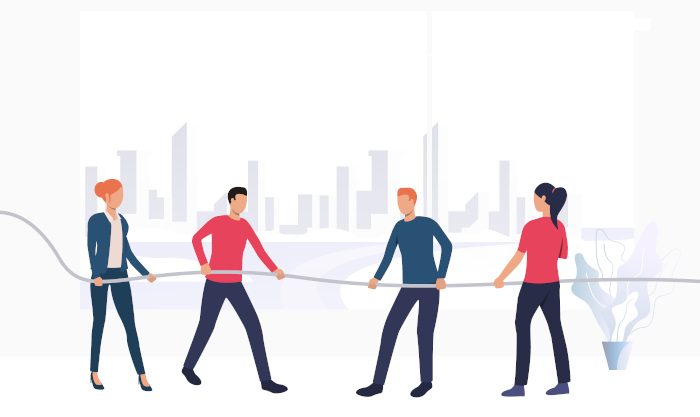We already know this.
Today’s teams are different from the teams of the past: They’re far more diverse, dispersed, digital, and dynamic (with frequent changes in membership). But while teams face new hurdles, their success still hinges on a set of fundamentals for group collaboration.
There are many factors that contribute to effective teamwork, but I decided to look at this subject from a slightly different angle.
Here’s how to improve teamwork in 5 not-so-obvious ways.
Define goals & set direction
The foundation of every great team is a direction that energizes, orients, and engages its members. Teams cannot be inspired if they don’t know what they’re working toward and don’t have explicit goals. Those goals should be challenging, but not so difficult that the team becomes dispirited. They also must be meaningful to the team and people have to care about achieving them.

Defining goals creates a sense of purpose and helps everyone drive in the same direction, whether it’s increasing revenue, improving customer satisfaction or building an outstanding product.
Build a diverse structure
Teams also need the right mix and number of members, optimally designed tasks and processes, and norms that discourage destructive behaviour and promote positive dynamics.

Every person on the team contributes specific strengths to the department and company.
They don’t have to possess superlative technical and social skills, but the team overall needs a healthy dose of both. Diversity in knowledge, views, and perspectives, as well as in age, gender, and race, can help teams be more creative and avoid groupthink.
Overcome “us vs them” thinking
Teams in larger organizations are often split into subteams. Additionally, each subteam may be located in a different geographical area. Such divisions can sometimes lead to a situation where one subteam wants to show that they’re better, more organized, or quicker to deliver their work on time.

Fortunately, there are many ways team leaders can actively foster a shared identity and shared understanding and break down the barriers to cooperation and information exchange. One powerful approach is to ensure that each subgroup feels valued for its contributions toward the team’s overall goals. It includes emphasizing that all subteams contribute necessary skills and that they depend on each other to achieve success.
Another way is to bring everyone together on a regular basis, align them towards the same goal, and highlight the importance of teamwork.
When you implement these tactics, your team members will start to view the team not as “us and them”, but as “we”.
Give individual praise but celebrate team success
To get the best out of people, a regular habit of giving encouragement on an individual level can go a long way. It boosts confidence and morale.
Make individual comments about your team members and explain what you liked about something they did, and how it is contributing towards the success of your project.
When you reach your goal, celebrate as a team. This will cement the team collaborative environment and will ensure that everyone understands the importance of teamwork.
Spread kindness

Let’s admit it. We all know that being kind is what we should all practice, but would you think about it as one of the main factors contributing to successful teamwork? Believe me, in the modern workplace of today, kindness is the best-kept secret to the most productive teams.
Why?
Because kindness creates an atmosphere of mutual trust and respect. In such an environment, everyone can give the best of themselves, take initiative, speak freely about their mistakes and how to fix them.
The result?
A group of people who work faster, more efficiently, and in a more collaborative way. So listen to each other more, be more attentive to your colleague’s feelings, and, most importantly, lead by example.
Collaboration makes employees more productive and creative. It helps us feel connected to our work and the people we work with. In general, it makes us happier people. Using these tips will guarantee better collaboration and a work environment that gets the best out of everyone in the organization.
If you work in a team to create visual content and would like your team to be more productive, more aligned and happier, sign up for a free 30-day trial of Piktochart for Teams, and let your team work smarter, not harder!


